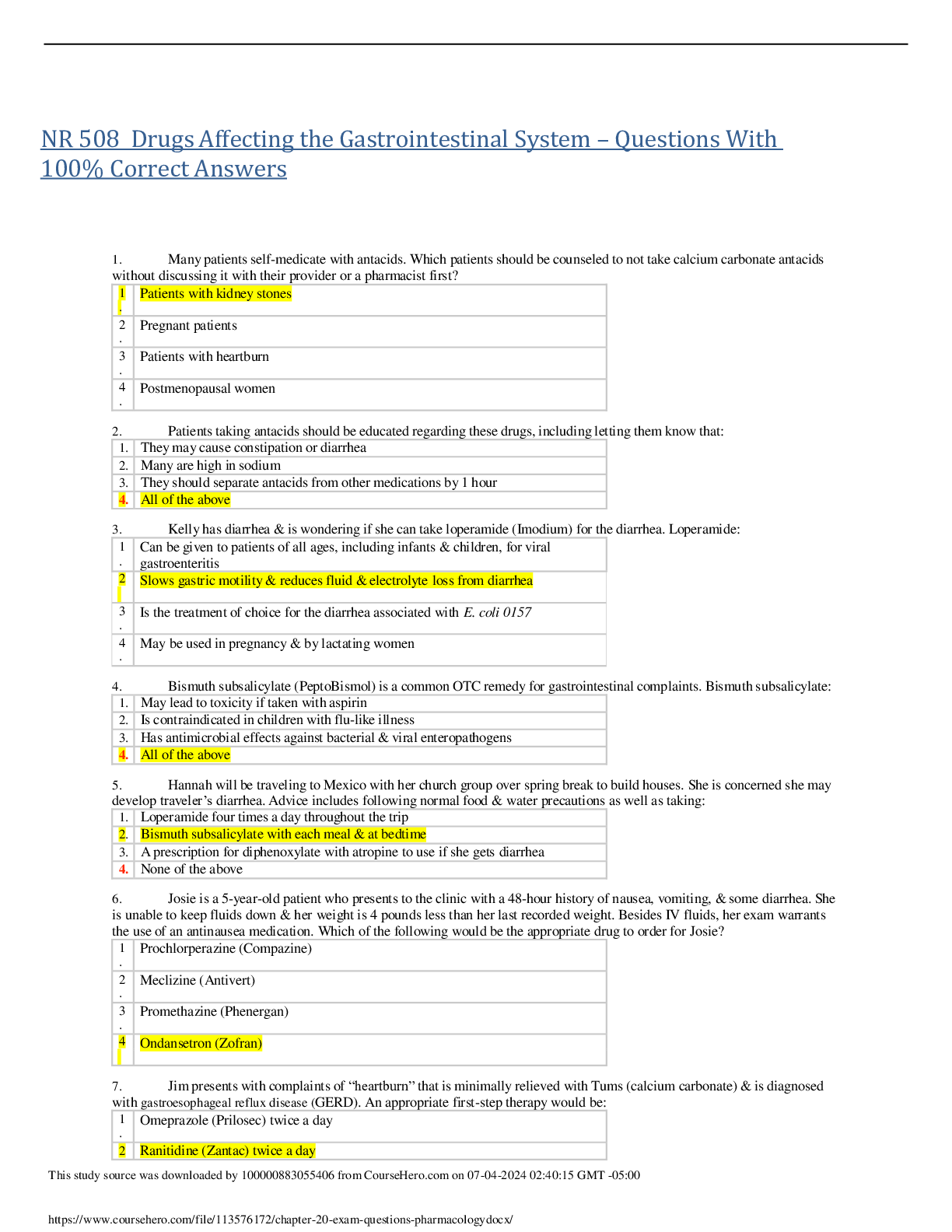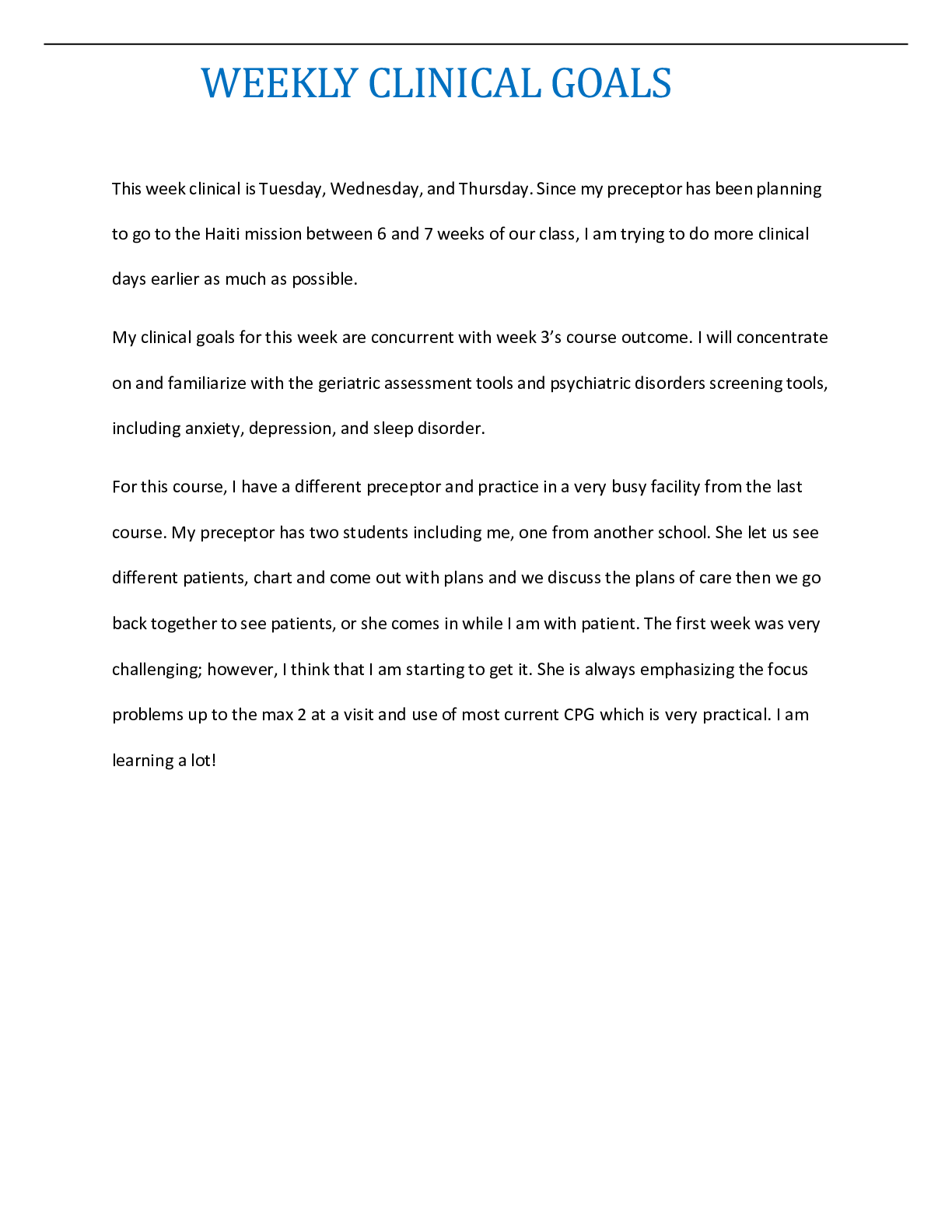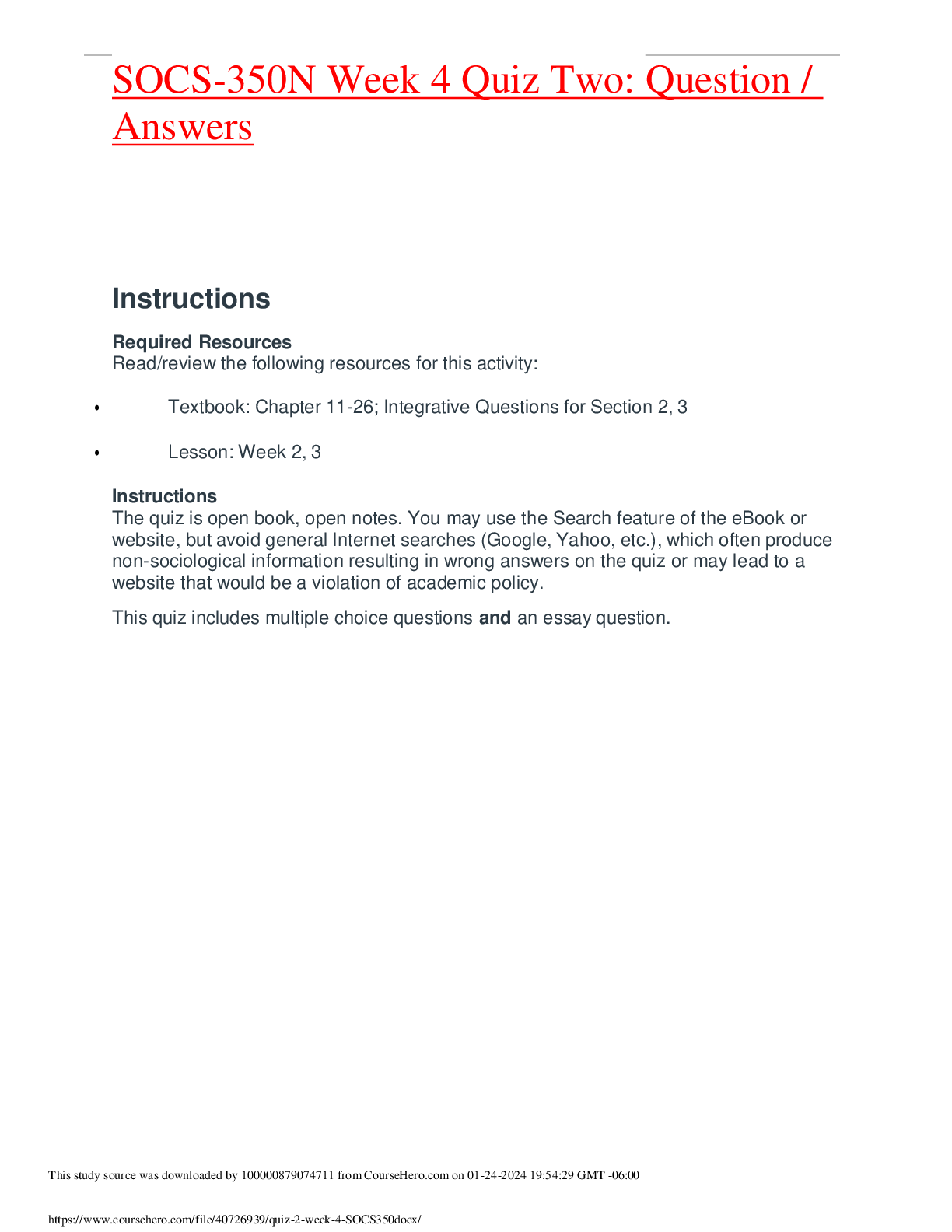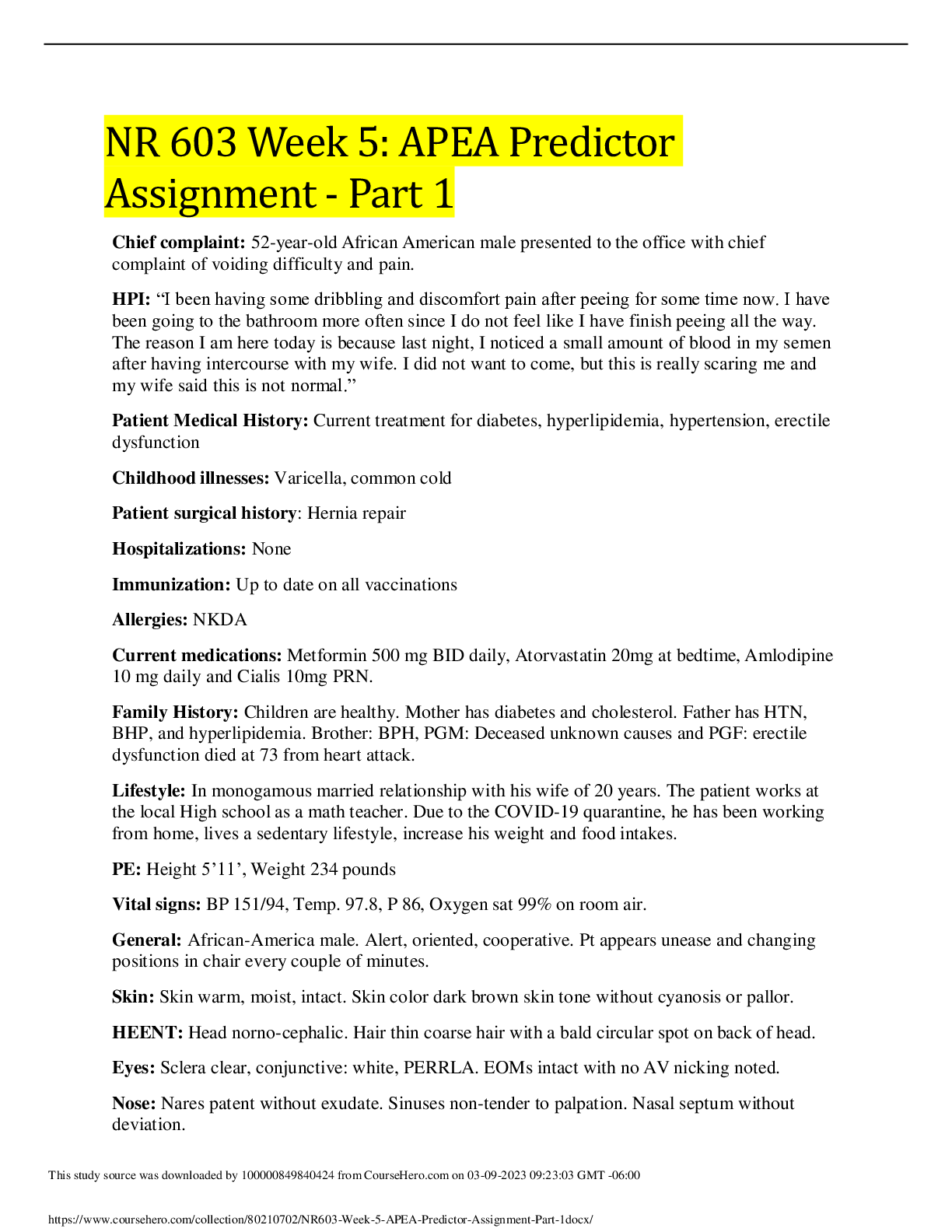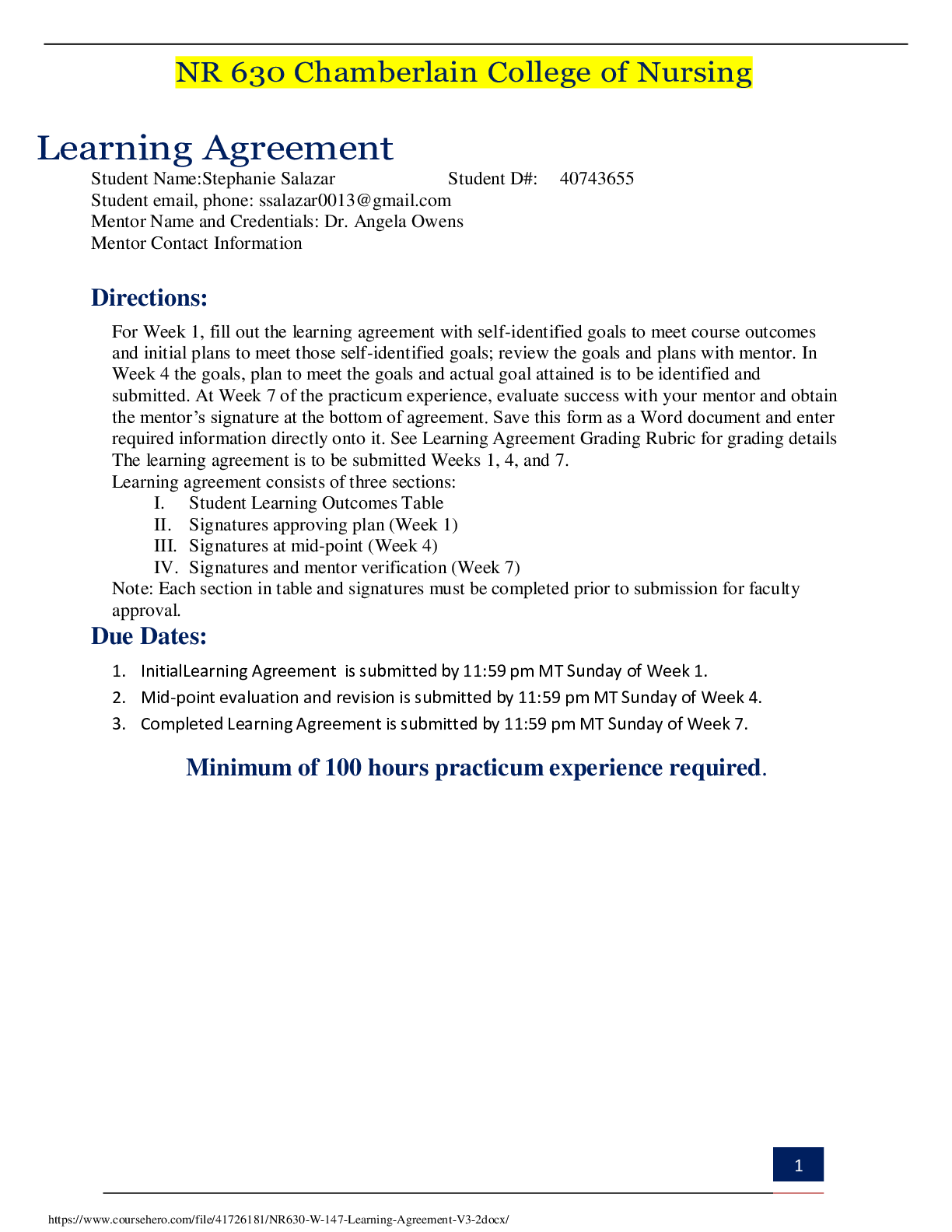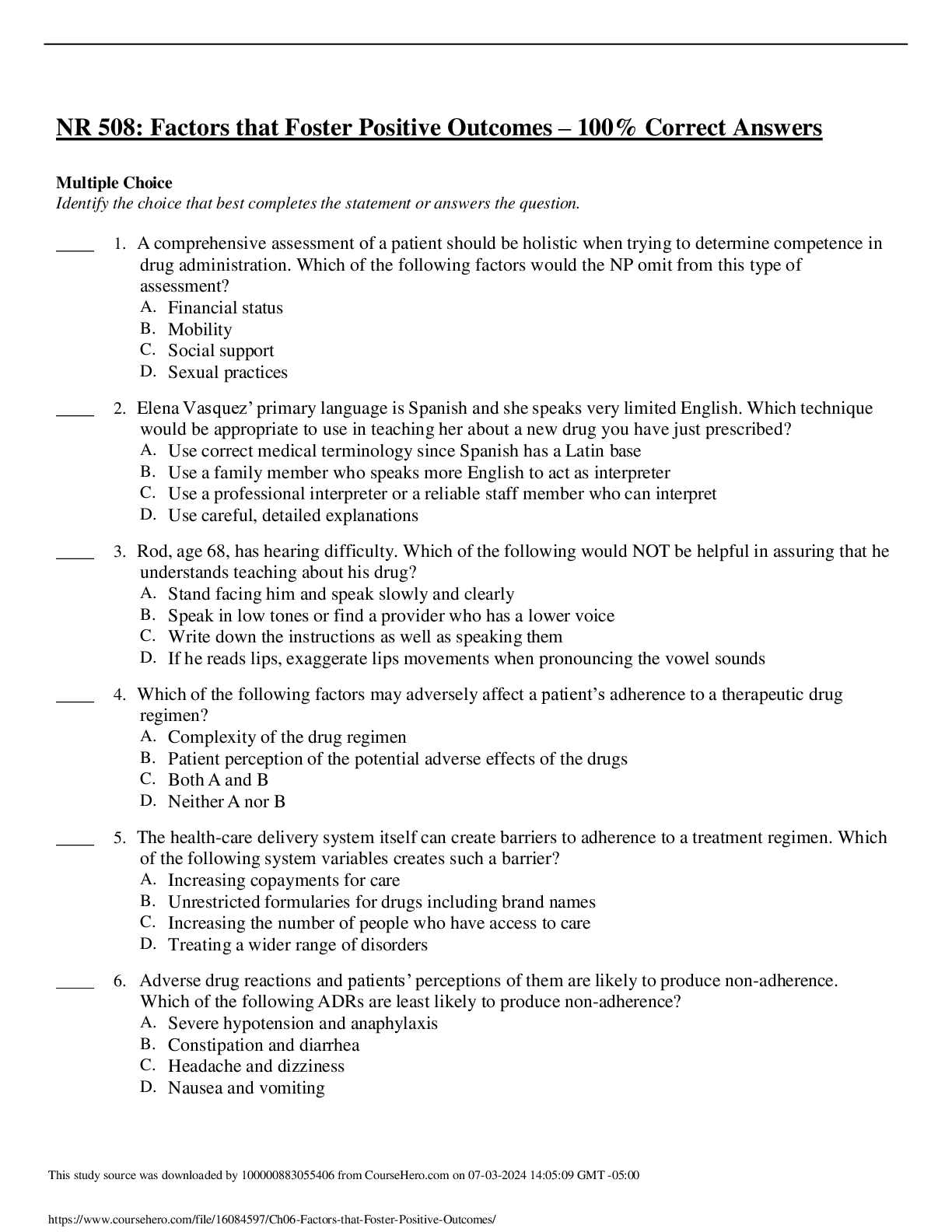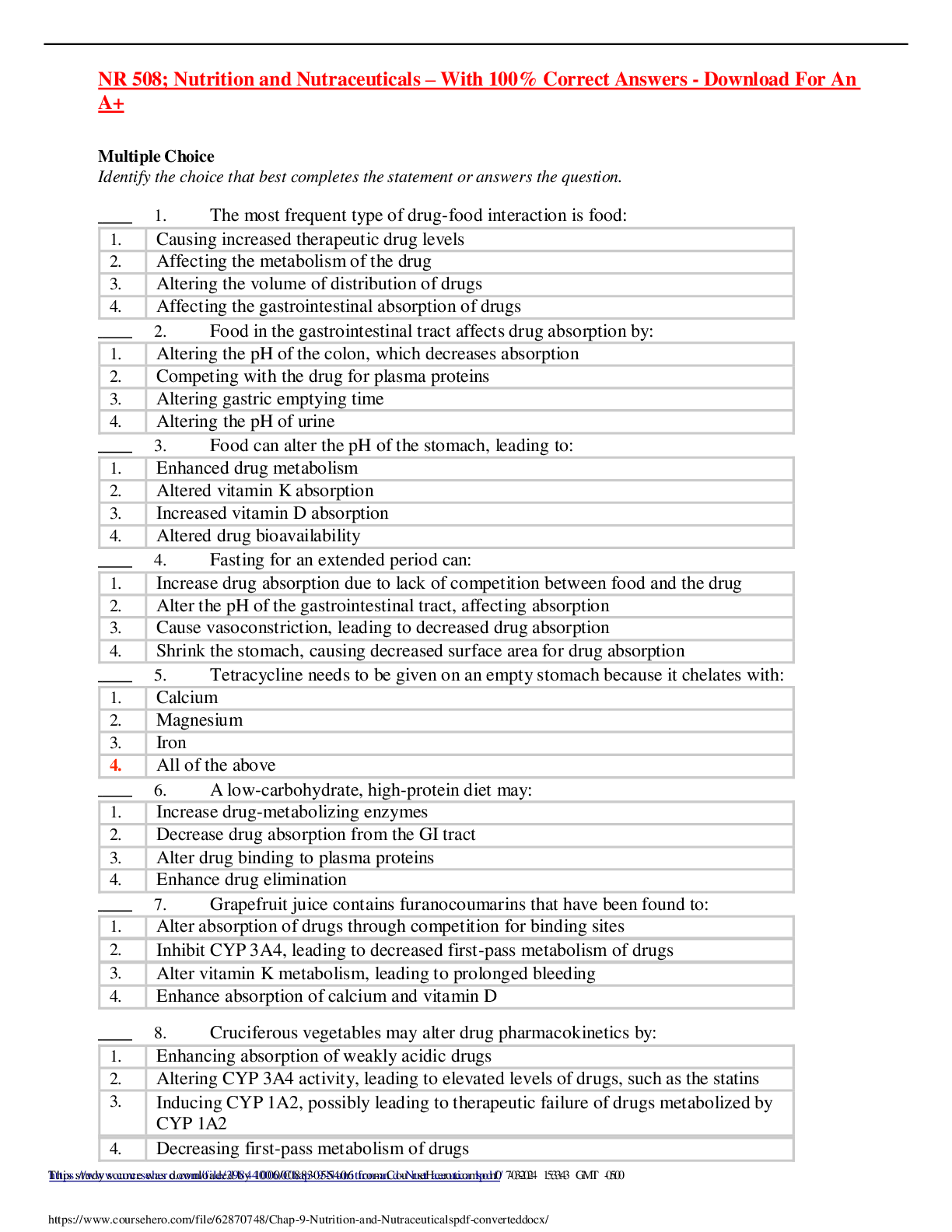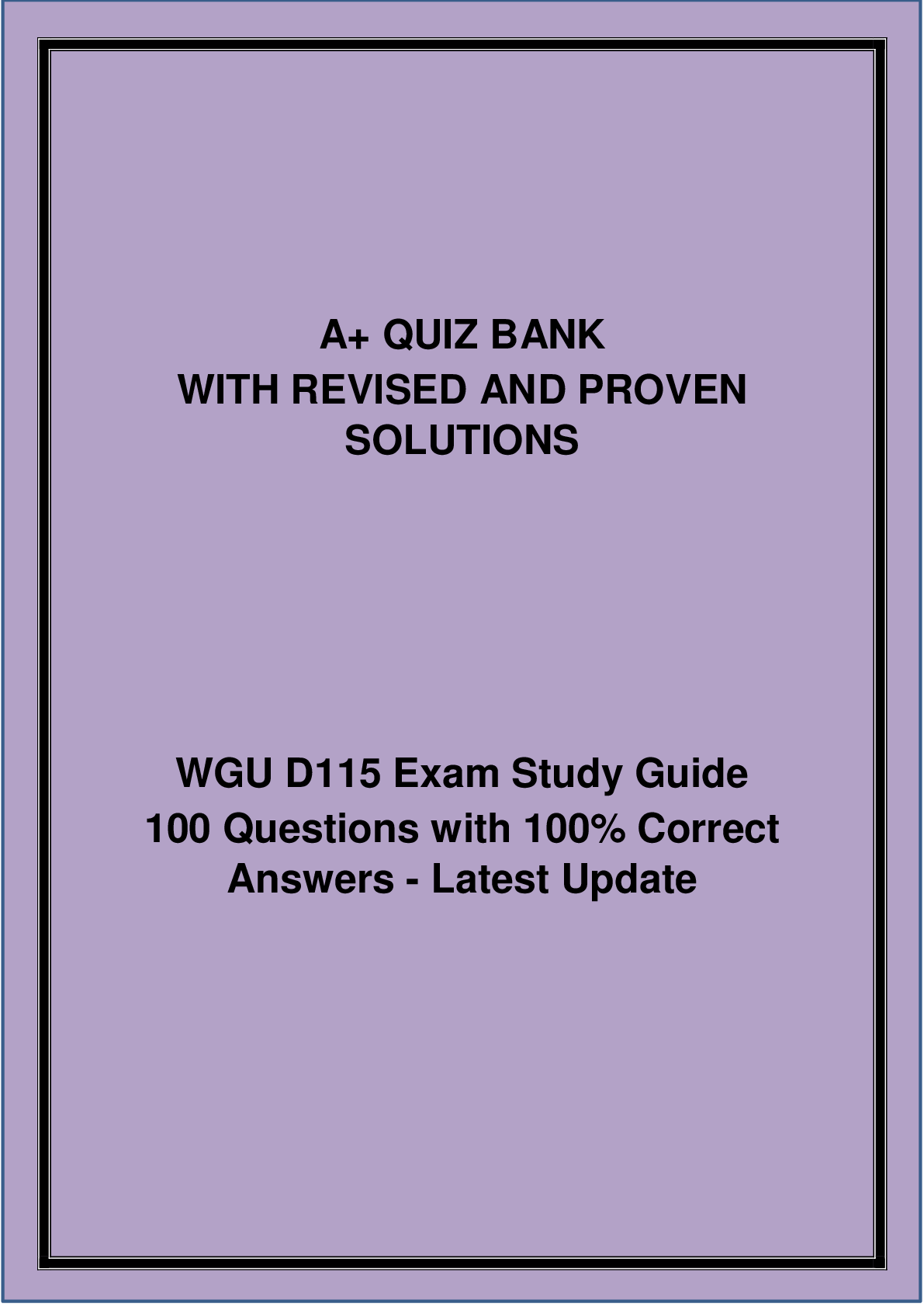Pharmacology for Nursing Care > QUESTIONS and ANSWERS > NR 508; Nutrition and Nutraceuticals – With 100% Correct Answers - Download For An A+ (All)
NR 508; Nutrition and Nutraceuticals – With 100% Correct Answers - Download For An A+
Document Content and Description Below
NR 508; Nutrition and Nutraceuticals – With 100% Correct Answers - Download For An A+ Multiple Choice Identify the choice that best completes the statement or answers the question. 1. The most ... frequent type of drug-food interaction is food: 1. Causing increased therapeutic drug levels 2. Affecting the metabolism of the drug 3. Altering the volume of distribution of drugs 4. Affecting the gastrointestinal absorption of drugs 2. Food in the gastrointestinal tract affects drug absorption by: 1. Altering the pH of the colon, which decreases absorption 2. Competing with the drug for plasma proteins 3. Altering gastric emptying time 4. Altering the pH of urine 3. Food can alter the pH of the stomach, leading to: 1. Enhanced drug metabolism 2. Altered vitamin K absorption 3. Increased vitamin D absorption 4. Altered drug bioavailability 4. Fasting for an extended period can: 1. Increase drug absorption due to lack of competition between food and the drug 2. Alter the pH of the gastrointestinal tract, affecting absorption 3. Cause vasoconstriction, leading to decreased drug absorption 4. Shrink the stomach, causing decreased surface area for drug absorption 5. Tetracycline needs to be given on an empty stomach because it chelates with: 1. Calcium 2. Magnesium 3. Iron 4. All of the above 6. A low-carbohydrate, high-protein diet may: 1. Increase drug-metabolizing enzymes 2. Decrease drug absorption from the GI tract 3. Alter drug binding to plasma proteins 4. Enhance drug elimination 7. Grapefruit juice contains furanocoumarins that have been found to: 1. Alter absorption of drugs through competition for binding sites 2. Inhibit CYP 3A4, leading to decreased first-pass metabolism of drugs 3. Alter vitamin K metabolism, leading to prolonged bleeding 4. Enhance absorption of calcium and vitamin D 8. Cruciferous vegetables may alter drug pharmacokinetics by: 1. Enhancing absorption of weakly acidic drugs 2. Altering CYP 3A4 activity, leading to elevated levels of drugs, such as the statins 3. Inducing CYP 1A2, possibly leading to therapeutic failure of drugs metabolized by CYP 1A2 4. Decreasing first-pass metabolism of drugs 9. Milk and other foods that alkalinize the urine may: 1. Result in basic drugs being reabsorbed in the renal tubule 2. Increase the elimination of basic drugs in the urine 3. Decrease the elimination of acidic drugs 4. Not alter drug elimination due to the minimal change in urine pH 10. Antacids such as calcium carbonate (Tums) can reduce the absorption of which of the following nutrients? 1. Protein 2. Calcium 3. Iron 4. Vitamin K 11. Phenytoin decreases folic acid absorption by: 1. Altering the pH of the stomach 2. Increasing gastric emptying time 3. Inhibiting intestinal enzymes required for folic acid absorption 4. Chelation of the folic acid into inactive ingredients 12. Patients taking warfarin need to be educated about the vitamin K content of foods to avoid therapeutic failure. Foods high in vitamin K that should be limited to no more than one serving per day include: 1. Spinach 2. Milk 3. Romaine lettuce 4. Cauliflower 13. The American Dietetic Association has recommended the use of specific nutritional supplements in the following population(s): 1. 400 IU per day of vitamin D in all infants and children 2. 1,000 IU per day of vitamin D for all pregnant women 3. 60 mg per day of iron for all adults over age 50 years 4. All of the above 14. The American Dietetic Association recommends pregnant women take a supplement including: 1. 1,000 IU daily of vitamin D 2. 2.4 mcg/day of vitamin B12 3. 600 mcg/day of folic acid 4. 8 mg/day of iron 15. The American Heart Association and the American Dietetic Association recommend a minimum daily fiber intake of for cardiovascular health: 1. 10 mg/day 2. 15 mg/day 3. 20 mg/day 4. 25 mg/day 16. Which of the following vitamin or mineral supplements may by teratogenic if a pregnant woman takes more than the recommended amount? 1. Iron 2. Vitamin A 3. Vitamin B6 4. Vitamin C 17. Vitamin B2 (riboflavin) may be prescribed to: 1. Decrease the incidence of beriberi 2. Reduce headaches and migraines 3. Prevent pernicious anemia 4. Treat hyperlipidemia 18. Isoniazid (INH) may induce a deficiency of which vitamin? 1. B6 2. C 3. D 4. E 19. Pregnant patients who are taking isoniazid (INH) should take 25 mg/day of vitamin B6 (pyridoxine) to prevent: 1. Beriberi 2. Peripheral neuropathy 3. Rickets 4. Megaloblastic anemia 20. Vitamin B12 deficiency may lead to: 1. Hair loss 2. Insomnia 3. Dry scales on the scalp 4. Numbness and tingling of the hands 21. Smokers are at risk for vitamin C deficiency. It is recommended that smokers take vitamin C supplement. 1. 100 mg/day 2. 500 mg/day 3. 1,000 mg/day 4. 35 mg/day more than nonsmokers 22. There is strong evidence to support that adequate vitamin C intake prevents: 1. The common cold 2. Breast cancer 3. Scurvy 4. All of the above 23. Adequate vitamin D is needed for: 1. Absorption of calcium from the gastrointestinal tract 2. Regulation of serum calcium levels 3. Regulation of serum phosphate levels 4. All of the above 24. Newborns are at risk for early vitamin K deficiency bleeding and the American Academy of Pediatrics recommends that all newborns receive: 1. IM vitamin K (phytonadione) within 24 hours of birth 2. Oral vitamin K supplementation in the first 3 weeks of life 3. Formula containing vitamin K or breast milk 4. Oral vitamin K in the first 24 hours after birth 25. Symptoms of folate deficiency include: 1. Thinning of the hair 2. Bruising easily 3. Glossitis 4. Numbness and tingling of the hands and feet 26. A patient with a new onset of systolic ejection murmur should be assessed for which nutritional deficiency? 1. Vitamin B12 2. Vitamin C 3. Folate 4. Niacine 27. According to the 2003-2006 National Health and Nutrition Examination Survey study of dietary intake, the group at highest risk for inadequate calcium intake was: 1. The elderly (over age 60 years) 2. Teenage females 3. Teenage males 4. Preschoolers 28. Patients with iron deficiency will develop: 1. Hemolytic anemia 2. Megaloblastic anemia 3. Macrocytic-hypochromic anemia 4. Microcytic-hypochromic anemia 29. There is evidence that dietary supplementation or adequate intake of fish oils and omega-3 fatty acids have well-documented: 1. Concern for developing cardiac dysrhythmias 2. Anti-inflammatory effects 3. Total cholesterol-lowering effects 4. Effects on fasting blood sugar 30. There is enough preliminary evidence to recommend that children with autism receive which supplemental nutrient? 1. Vitamin B1 (thiamine) 2. Vitamin B2 (riboflavin) 3. Calcium 4. Omega-3 fatty acids 31. There is sufficient evidence to support the use of omega-3 fatty acids to treat the following disease(s): 1. Asthma 2. Autism 3. Arthritis 4. All of the above 32. It is reasonable to recommend supplementation with in the treatment of hyperlipidemia. 1. Omega-3 fatty acids 2. Probiotics 3. Plant sterols 4. Calcium 33. Probiotics are recommended to be co-administered when are prescribed: 1. Antacids 2. Antihypertensives 3. Antidiarrheals 4. Antibiotics 34. It is reasonable to add to a Helicobacter pylori treatment regimen to improve eradication rates of H. pylori. 1. Probiotics 2. Omega-3 fatty acids 3. Plant sterols 4. Fiber Chapter 9. Nutrition and Nutraceuticals Answer Section MULTIPLE CHOICE 1. ANS: 4 PTS: 1 2. ANS: 3 PTS: 1 3. ANS: 4 PTS: 1 4. ANS: 3 PTS: 1 5. ANS: 4 PTS: 1 6. ANS: 1 PTS: 1 7. ANS: 2 PTS: 1 8. ANS: 3 PTS: 1 9. ANS: 1 PTS: 1 10. ANS: 3 PTS: 1 11. ANS: 3 PTS: 1 12. ANS: 1 PTS: 1 13. ANS: 1 PTS: 1 14. ANS: 3 PTS: 1 15. ANS: 4 PTS: 1 16. ANS: 2 PTS: 1 17. ANS: 2 PTS: 1 18. ANS: 1 PTS: 1 19. ANS: 2 PTS: 1 20. ANS: 4 PTS: 1 21. ANS: 4 PTS: 1 22. ANS: 3 PTS: 1 23. ANS: 4 PTS: 1 24. ANS: 1 PTS: 1 25. ANS: 3 PTS: 1 26. ANS: 3 PTS: 1 27. ANS: 2 PTS: 1 28. ANS: 4 PTS: 1 29. ANS: 2 PTS: 1 30. ANS: 4 PTS: 1 31. ANS: 2 PTS: 1 32. ANS: 3 PTS: 1 33. ANS: 4 PTS: 1 34. ANS: 1 PTS: 1 [Show More]
Last updated: 11 months ago
Preview 3 out of 7 pages

Loading document previews ...
Buy this document to get the full access instantly
Instant Download Access after purchase
Buy NowInstant download
We Accept:

Reviews( 0 )
$16.00
Can't find what you want? Try our AI powered Search
Document information
Connected school, study & course
About the document
Uploaded On
Jul 04, 2024
Number of pages
7
Written in
Additional information
This document has been written for:
Uploaded
Jul 04, 2024
Downloads
0
Views
44

